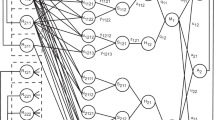Abstract
This paper studies the combined task of determining a favorable machine configuration and line balancing (MCLB) for an assembly line where a single type of printed circuit board is assembled by a set of interconnected, reconfigurable machine modules. The MCLB problem has been solved previously by heuristic methods. In the present work, we give a mathematical formulation for it and transform the model into a linear integer programming model that can be solved using a standard solver for problems of moderate size. The model determines the best machine configuration and allocation of components to the machine modules with the objective of minimizing the cycle time. Because the solutions found in this way are globally optimal, they can be used to evaluate the efficiency of previous heuristics designed for the MCLB problem. In our experiments, an evolutionary algorithm gave near optimal results.
Similar content being viewed by others
References
Ayob M, Kendall G (2008) A survey of surface mount device placement machine optimization: machine classification. Eur J Oper Res 186:893–914
Yilmaz IO, Gunther HO, Jain S (2009) Simulation of mixed model PCB assembly lines with group setup and bypass conveyors. Int J Adv Manuf Technol 42(3–4):335–347
Ho W, Ji P, Dey PK (2008) Optimization of PCB component placements for the collect-and-place machines. Int J Adv Manuf Technol 37:828–836
Sze MT, Ji P, Lee WB (2001) Modeling component assignment problem in PCB assembly. Assem Autom 21:55–60
Ashayeri J, Selen W (2007) A planning and scheduling model for onsertion in printed circuit board assembly. Eur J Oper Res 183:909–925
Ball OM, Magazine MJ (1988) Sequencing of insertions in printed circuit board assembly. Oper Res 36(2):192–201
Leipälä T, Nevalainen O (1989) Optimization of the movements of a component placement machine. Eur J Oper Res 38:167–177
Ji P, Sze MT, Lee WB (2001) A genetic algorithm of determining cycle time for printed circuit board assembly. Eur J Oper Res 128:175–184
Ammons JC, Carlyle M, Granmer L, Depuy GW, Ellis KP, McGinnis LF, Tovey CA, Xu H (1997) Component allocation to balance workloads in printed circuit card assembly. IIE Trans 29:265–275
Grunow M, Gunther HO, Schleusener M, Yilmaz IO (2004) Operations planning for collect-and-place machines in PCB assembly. Comp Indust Eng 47:409–429
Tirpak TM, Mohapatra PK, Nelson PC, Rajbhandari RR (2002) A generic classification and object-oriented simulation toolkit for SMT assembly equipment. IEEE Trans Syst Man Cybern Syst Hum 32(1):104–121
Ahmadi RH, Wurgaft H (1994) Design for synchronized flow manufacturing. Manage Sci 40:1469–1483
Toth A, Knuutila T, Nevalainen OS (2010) Reconfiguring flexible machine modules of a PCB assembly line. Prod Eng Res Dev 4(1):85–94
Rong A, Toth A, Nevalainen O, Knuutila T, Lahdelma R (2009) PCB assembly line modeling with modular placement machines. Proceedings of the 2009 IEEE International Conference on Industrial Engineering and Engineering Management (IEEM 2009), 1097–1101
Gutjahr AL, Nemhauser GL (1964) An algorithm for the line balancing problem. Manage Sci 11:308–315
Baybars I (1986) A survey of exact algorithms for the simple assembly line balancing problem. Manage Sci 32:909–932
Becker C, Scholl A (2006) A survey on problems and methods in generalized assembly line balancing. Eur J Oper Res 168:694–715
Lapierre SD, Ruiz A, Soriano P (2006) Balancing assembly lines with tabu search. Eur J Oper Res 168:826–837
Amen M (2006) Cost-oriented assembly line balancing: model formulations, solution difficulty, upper and lower bounds. Eur J Oper Res 168:747–770
Scholl A, Becker C (2006) State-of-art exact and heuristic solution procedures for simple assembly line balancing. Eur J Oper Res 168:666–693
Lin WL, Tardif V (1999) Component partitioning under demand and capacity uncertainty in printed circuit board assembly. Int J Flex Manuf Syst 11:159–176
Hiller MS, Brandeau ML (2001) Cost minimization and workload balancing in printed circuit board assembly. IIE Trans 33:547–557
Kodek DM, Krisper M (2004) Optimal algorithm for minimizing production cycle time of a printed circuit board assembly line. Int J Prod Res 42(23):5031–5048
Lapierre SD, Debargis L, Soumis F (2000) Balancing printed board assembly line systems. Int J Prod Res 38(16):3899–3911
Tazari S, Muller-Hannemann M, Weihe K (2006) Workload balance in multi-stage production processes. Lect Notes Comput Sci 4007:49–60
Häyrinen T, Johsson M, Johtela T, Smed J, Nevalainen O (2000) Scheduling algorithms for computer-aided line balancing in printed circuit board assembly. Prod Plan Control 11:497–510
Yildirim MB, Duman E, Duman D (2006) Dispatching rules for allocation of component types in automated assembly of printed circuit boards. Lect Notes Comput Sci 4263:55–64
Choudhury ND, Wilhelm WE, Rao B, Gott J, Khotekar N (2007) Process planning for circuit card assembly on a series of dual head placement machines. Eur J Oper Res 182:626–639
Kulak O, Yilmaz IO, Gunther HO (2008) GA-based solution approach for balancing printed circuit board assembly line. OR Spectr 30:469–491
Wan YF, Ji P (2001) A tabu search heuristic for the component assignment problem in PCB assembly. Assem Autom 21(3):236–240
Khoo LP, Alisantoso D (2003) Line balancing of PCB assembly line using immune algorithms. Eng Comput 19:92–100
Lahdelma R,Nurminen J, Ruuth S (1986) Implementations of LP and MIP systems. EURO VIII; Lisbon also in Helsinki University of Technology, Systems Analysis Laboratory Research Reports A18
Author information
Authors and Affiliations
Corresponding author
Rights and permissions
About this article
Cite this article
Rong, A., Toth, A., Nevalainen, O.S. et al. Modeling the machine configuration and line-balancing problem of a PCB assembly line with modular placement machines. Int J Adv Manuf Technol 54, 349–360 (2011). https://doi.org/10.1007/s00170-010-2920-z
Received:
Accepted:
Published:
Issue Date:
DOI: https://doi.org/10.1007/s00170-010-2920-z




